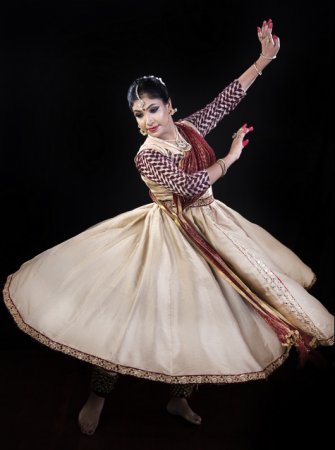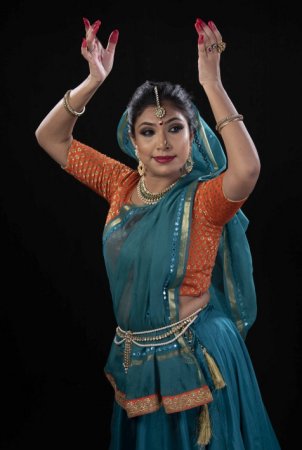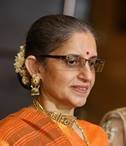
|
 |

|
 |
Sangita Chatterjee on working with a Bharatanatyam mentor - Shveta Arora e-mail: arorashveta1806@gmail.com May 9, 2022 "When you are alone choreographing something, you want a second eye to see what is not going right," says Sangita Chatterjee on working with a Bharatanatyam mentor. Sangita Chatterjee is a Kathak dancer, choreographer and teacher whom I have been watching with interest for many years. She has learnt Kathak from Guru Vaswati Misra but has developed a distinct dance identity marked by conceptual richness and intellectual exploration in her presentations. She has also organized events through her dance and arts company, Kalpataru Arts. She recently choreographed and performed a piece for Pratiroop, an online dance event organized by Divya Warier. Pratiroop paired an established dancer in one dance form as a mentee with a guru from another dance form as a mentor, and asked them to come up with a short, fresh piece for digital broadcasting. Sangita was paired with Bharatanatyam guru Rama Vaidyanathan and presented a thought-provoking piece called Manthani. I spoke to her about it afterwards and also discussed performing for the camera as compared with performing for a physical audience.  Mentoring under Rama Vaidyanathan First of all, Pratiroop in itself is a unique platform which gives the opportunity to not only work under senior artistes but also experience cross-mentorship, which is interesting, since you might work under gurus otherwise, but usually in the same art form. Personally, what I could comprehend was that viewing Bharatanatyam so far had been a different experience, and understanding the mind of a Bharatanatyam guru was a very different undertaking. It was a very enriching experience for me personally, especially when I had a mentor like Rama Vaidyanathan. Of course, all the youngsters are very much in awe of her. I had been working on my own for a few years and creating my own choreographies. The moment I heard that she was my mentor, I decided to take up a subject which was non-linear, or something I would not attempt readily, something challenging for me where the narrative was not clearly visible. Hence, I chose the concept of samudra manthan (churning the ocean of milk in Hindu mythology), which I later called Manthani (the vessel in which something is churned). The idea had been there for a long time. Kalpataru Arts (Sangita's arts organization) called its first festival Manthan (churning), which was started in 2015. Since 2015, it has been an annual festival where Rama akka has also performed once. Since then, the seed has been there - I wanted to always do something on the interpretation of samudra manthan, not the way we have heard and seen it depicted but the way I see it in the light of my understanding of today's circumstances. So that idea had been with me for a long time, but then the pandemic also gave me a lot to think about the process of manthan. You have seen the film I did, 'The Quest'. In that to, there was the vague sense of a churning. I thought, I would like to explore this further, and when I am getting a mentor like Rama akka, who is known for her thought process, why not? I was very keen to understand how she would approach this subject, which is absolutely non-linear. As a story we all know it, but I have not touched that story at all in the production. I have only worked on the interpretation of what that word means to us, on the internal churning or atma manthan. That is where I thought it would be great to have her vision and how she would give imagery to that in the form of an idea. That was very interesting about working with her. Conflicts between the mentor's and mentee's forms I believe that after a point, you are so immersed in the form that Kathak can't be removed from the dancer's body... whatever I do, it will be Kathak. The Pratiroop platform was also intended not to interfere with the dancer's form, but to allow the mentor to help the dancer internalize the thought process and create a new piece conceptually. And then one has to do it in their own medium. Even if it influenced the form, it was only a little bit, and I personally had no difficulty in adapting. Many of the inputs Rama akka gave me are going to further enhance my explorations, especially the abhinaya aspect of it, or certain places where she insisted on getting into more stillness of the form. I am a Kathak dancer who always likes thehrav (stillness and restraint); people say that I show it and I love it in my dancing. Having said so, working with her, it was reaffirmed how that stillness can really bring out the essence of what you want to convey. Dancing from the heart instead of displaying technique and changing the movement with the beat Yes, we changed the movement with the beat when showing the increasing turbulence of the churning. We really wanted to bring out this aspect of something happening within, but the individual not being able to understand it. When the pandemic hit us, I was able to relate to this because we were taken aback and unable to understand what was happening. That uncertainty and ambiguity all must come out in the abstraction of that churning. So we thought there should be different abstract emotions depicted: sometimes ambiguity, sometimes anger, sometimes confusion, so all kinds of disturbances which were happening (during the lockdowns). The entire churning has been shown - initially, the piece starts with a lot of mess because it is a mess one goes through when the churning first begins. But as the piece ends, the churning continues but the expression changes to a very calm one. So that's why I said (in the performance), let the churning continue. Now that you have understood that the churning is important for you to grow, you won't resist it. The resistance to it goes away. Initially, there is a great deal of resistance to the churning - why is it happening to me, what is this din and why? What is happening to me? That was the questioning part. Later, it was 'mathomathani, mathomathani (churn, vessel, churn)'- let it continue. The poetry says 'man mandar rahyo achal, aaj hoye kahe vikal' - my mind is as firm as Mount Mandar, why is it being pulled apart now? That scene of being pulled each way depicts every emotion, happiness, anger, negative and positive emotions, occurring constantly within one's mind. It is a flickering mind. The rope, Vasuki, the snake, is also the rope of desire. Vasuki has always been compared with desire (in interpretations of the samudra manthan). Human beings have many desires. One moment we are pulled to one side by the rope, by one desire, then to the other side by another desire. Samudra is of course one's own mind and entity, from where I say that there is infinite possibility, like the ocean has infinite possibilities. From my life I can bring out the infinite possibilities of confronting any problems; that is why this churning is very important. The physical body is the manthani. Manthani is the pot in which the manthan happens. Ghada jisme manthan kar rahe hain (the pot in which the churning is happening) - my body is that manthani. From my life, which is surpassing my bodily limits, from that entity of life there are infinite possibilities coming out like amrit (nectar). That amrit is awareness: when we start becoming aware of our own being, and start taking decisions from that awareness or wisdom. The entire samudra manthan is reinterpreted into a depiction in which I see it happening within my human body.  The process of choreographing for video We spent one and a half months working on this, though I would have loved to have more time. It started with one or two online sessions with Rama akka where she asked me about my concept; I threw up this idea and she liked it. Then we discussed how we wanted to put that in images. I was going to her studio in Delhi about once a week. After all that discussion, she asked me to write what I wanted to say, so the entire poetry, it was translated from what I wanted to convey. First I wrote it in English, the entire text, then I gave it to Himanshu Srivastava (artist, Bharatanatyam dancer and scholar), who translated it into Brajbhasha. From there on, I started choreographing in my studio. I did the basic structure, then I gave it to Rama akka, who gave her inputs. Each time I went to her, she would give her feedback. Then we worked on the music. Again, with her ideas, I created the music with my musicians and then went back to her. I did the entire choreography but under her constant supervision. The most interesting part of this process was the many conversations we had: why not this and why that, those talks were very important. The entire concept was creating the idea. At this stage of my career, nobody would tell me, move like this etc. - that much you are equipped with. The input is how do you visualize an idea, how you develop the right kind of imagery. Many times, in the movement, when I showed her, this is what I am planning, she would say, why don't you do it this way? I felt very secure, because in creating a new work, that too within a short time, you always feel, when you are alone choreographing something, you really want someone to watch, a second eye to see what is not going right. Here, I was very secure that I had such a good, critical eye, someone who would tell me when I was not going in the right direction. Working with her was a blessing. She has empowered me in very aspect. That was actually the intention of Pratiroop also - empowering artistes by pushing them to go beyond their comfort zone. This platform was a unique platform: we hardly ever work in this way. We usually work on our own only. I did 'Yagyaseni' just before the pandemic, a one and a half hour solo dance theatre production, but I was all alone, doing everything myself. Here, I was very privileged to have Rama akka. I'm now looking forward to presenting it on stage. Somehow, I felt this is not for the virtual platform, though we had no option but that medium at that time. But this production is meant for a closely knit kind of audience and to be performed on stage. 'Devi' is okay online, that I visualized for the camera, but this, though I knew I had to film it, ultimately, the next time I get an opportunity to perform on stage, this will have a better impact there. I was a little upset after doing the virtual performance that it was not live, but I am looking forward to dancing on stage soon!  Shveta Arora is a dance-mad writer who chronicles classical dance events in Delhi (and also those online). In 2009, she started the blog Kala Upasana at delhiculturecomment.blogspot.com, where she began posting her own writing along with photographs clicked by Anoop Arora, her husband. She's been dancing all her life as a devotee, but resumed her formal training in Kathak in her 50s and has passed her fifth year Kathak exams. Post your comments Please provide your name and email id when you use the Anonymous / blog profiles to post a comment. All appropriate comments posted with name and email id in the blog will be featured in the site. |